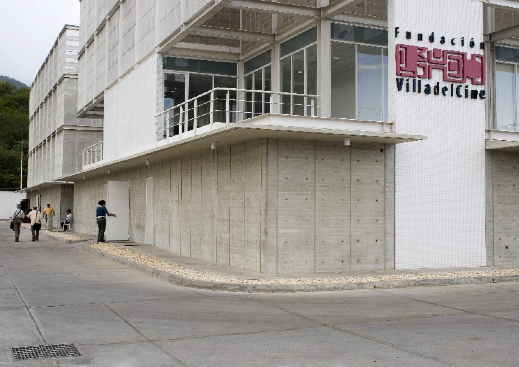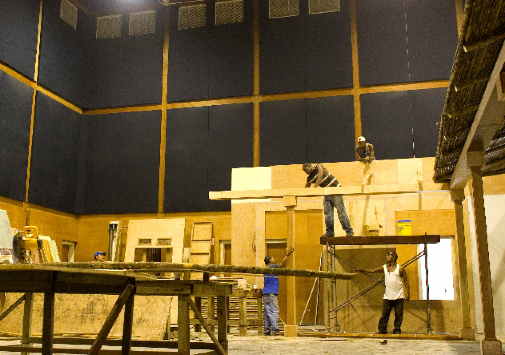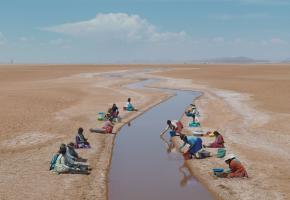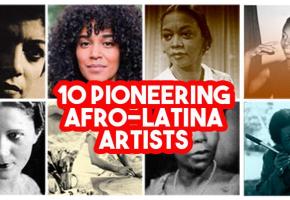Gunshots echo as motorbike tyres flare up the dust of the dry neglected roads. Residents of a Caracas barrio gather to mourn the death of Edwin, another suspected victim of trigger-happy police. Through the chaos the camera rests on the troubled detatched face of Tita, a girl seated on the backseat of a motorcycle. As the funeral procession proceeds, she watches the hearse move away and the solemn melody of a single violin begins to drown out the street noises. Tita speeds off and the music brings us to an auditorium where Tita arrives and walks towards an orchestra – her refuge. Today, however, she cannot be at rest. Sat amongst the orchestra, Tita stares despairingly into the distance, as Edwin’s body is laid to rest, and the sombre voice of the Priest is overlaid with the impassioned violin playing of a young girl at the rehearsal.
Villa del Cine and 'New Venezuelan Cinema'
This scene from the recently released Venezuelan film La Clase (José Antonio Varela, 2007) embodies the ethos and fervour of a new cinema that is taking root in the country. While exploring issues central to the Bolívarian Revolution, the internationally acclaimed film attempts to provoke discussion concerning Venezuela’s tumultuous political past and continuing social conflicts. Set in the late 1980s, La Clase follows the personal tribulations of Tita as she struggles to reconcile her dream of becoming a violinist with her life in the barrios of Caracas and her burgeoning political consciousness. Through a highly inventive use of image and sound editing the film juxtaposes the stark differences between the lives of the Venezuelan working and middle classes and, through doing so, encapsulates the central conflict that gave rise to the riots of El Caracazo in February 1989.
La Clase was one of the first films produced by Villa del Cine (Cinema City) -a multi-studio complex established by the Chávez Government in 2006, 35 kilometres outside Caracas. Providing the facilities to produce a range of audio-visual material for Venezuelan cinema and television, the state funded production company is part of Chávez’s wider policies to generate an alternative to US cultural Imperialism, fuelled most notably by studios of Hollywood. As Villa del Cine’s official website declared, its aim is to offset the reality that 98% of films exhibited in Venezuela are made in Hollywood, with an infrastructure that supports Venezuelan filmmaking and “encourages through its audio-visual productions the identity and cultural diversity of the Venezuelan people and the values of liberty, solidarity, justice and peace.”
Hollywood antidote or government propaganda?

While Villa del Cine is still in its infancy, La Clase, with its experimental flair, engaging narrative and convincing acting, exemplifies the potential for a thriving film industry within Venezuela. However the underlying Socialist leaning of La Clase, as with a number of Villa del Cine productions, has raised concerns that projects not purporting a particular ideology will be shunned, ultimately stunting the growth of creativity. Is Villa del Cine simply a tool of state censorship and ideological control, or can it succeed in providing aspiring filmmakers with the opportunity and artistic freedom to create visually outstanding and conceptually challenging films?
Jonathan Jakubowicz, a Venezuelan filmmaker who earned international acclaim with his film Secuesto Express (2005), recently said that Villa del Cine will only support films ‘that portray the revolution as the solution of all the problems of the nation or they want movies that tell the stories of independence leaders, always with a version that favours values that can be used to celebrate the Bolivarian Revolution…I don't think there's any chance to make movies that are not in tune with the revolution.’
Sergio Marcano, on the other hand, also a Venezuelan filmmaker, does not see the government’s involvement as being negative. "It seems to me entirely valid that the Venezuelan State should want to support cinema that evokes national interests and values, foments political ideologies and social and moral awareness, etc. Recall Cuban cinema of the 60s, it produced some great works such as Tomas Gutiérrez Alea’s Memorias del Subdesarrollo. Why should we deny ourselves this same possibility?"
Following the great Russian and Cuban traditions
Indeed Cuba, like the Soviet Union, perceived cinema as playing a vital part in the creation of its new society, in particular as a means to create social cohesion and as a form of mass communication in its post-revolutionary State. Out of the post- revolutionary cinema in the Soviet Union of the 1920s, emerged filmmakers such as Sergei Eisenstein (Strike, 1925) and Dziga Vertov (Man with a Movie Camera, 1929), who, ideological leanings apart, revolutionised many formal elements of filmmaking including editing and the relationships between sound and image. Indeed, their films are still considered essential to film studies courses around the world.
Similarly much of the Cuban cinema that emerged out of the Cuban Revolution, such as La Muerta de la Burócrata (Alea Tomas Gutiérrez, 1966), Soy Cuba (Mikhail Kalatzov, 1964) and Lucía (Humberto Solas, 1968), is considered iconic. These filmmakers were inspired to create conceptually and formally innovative films by the changes taking place in their countries and to formulate a new cinematic language for the people to represent themselves and to capture the spirit of the period. They aimed to offer an alternative to mainstream ideologies and, particularly in the case of Cuba, bring cinema to the masses.
In search of 'our language'
Dr Sandra Angeleri points out that Villa del Cine is not a replica of Russian and Cuban models of cinema, but has developed from a very different set of influences. "Globalisation, the developments in technology and the dominance of financial capital are the things which characterise the current climate. Rather than imitating another model, Villa del Cine is a national response, stemming from local concerns, to a particular ideology that is purveyed by powerful international media companies and dominates our media, in particular cinema."
In response to fears that Villa del Cine is just another byword for ‘censorship’ Dr Angeleri asks. Is mainstream cinema not a model of censorship and ideology itself? Is Hollywood not central to creating myths, upholding a particular way of life, the capitalist way? indeed, few people consider Hollywood as propaganda because they see it as normal. “What we are doing is creating of an alternative mythology to that of the ideological hegemony of Capitalism,” says Angeleri. “The cinema is an important element in the creation of an alternative vision of the world and the Bolivarian process looks to generate this alternative vision."
Thus rather than smothering diversity in opinion, Villa del Cine perhaps adds to that diversity. It does not have to be balanced, by simply being an alternative, it is providing the balance. Furthermore, as opposed to being dictated to by corporate backers, as is often the case in Hollywood, serving the interests of a small but powerful elite, this state funded production company aims to utilise cinema to redirect popular attention, ‘in search for our language,’ a language of and for the Venezuelan people.
Opportunities for all?

Laura Romero the Project Coordinator at Villa del Cine from January 2007 till July 2009, insists that state funding opens up rather than limits the choices available to filmmakers, ‘Finance goes through the National Autonomous Centre of Film (CNAC), a mixed commission consisting of representatives from the private sector and from state institutions, who debate over months the films to be funded. Villa del Cine, does not decide who does and who does not receive funding. Villa del Cine produces and co-produces, which is very different from the function of CNAC. A director or producer has the freedom to create and exhibit their work independently with funding from CNAC.’
From documentaries such as Venezuela Petroleum Company(Marc Villá, 2007), addressing the impact of oil on Venezuela, to feature films including Miranda Regresa (Luis Alberto Lamata, 2007), central to these works is the exploration of contemporary Venezuelan society. These films, however, do not suggest that Venezuela has suddenly resolved all of its problems, but highlight critical issues still affecting Venezuelans and encourage spectators to actively engage with the work.
Cinema as industry and employer
Sergio Marcano believes that its greatest impact so far has been to provide jobs for a new generation through the creation of the Platform of Film and Audio-Visual Media, which encompasses a diverse range of institutions dedicated to creating a stable Venezuelan film industry, from technicians and production to the creative side and distribution. Young filmmakers now have the opportunity to become involved in the industry and realise their first works, Macuro and La Clase are two examples. Furthermore, filming is now taking place within Venezuela rather than abroad as had previously been the case, allowing filmmaking to contribute directly towards the local economy. For example, shoe makers and artisans from Guarenas were employed to make 200 pairs of shoes forMiranda Regresa (2007).
The fine line between propaganda and promoting solidarity is one that will always be fiercely debated. However, while there are some concerns among the filmmaking community and complaints of bureaucracy, there is also a real passion and appreciation for how film can be utilized and a consensus among many that the work of Villa del Cine is a vital stepping-stone to the development of a fully functioning and flourishing Venezuelan film industry.

















